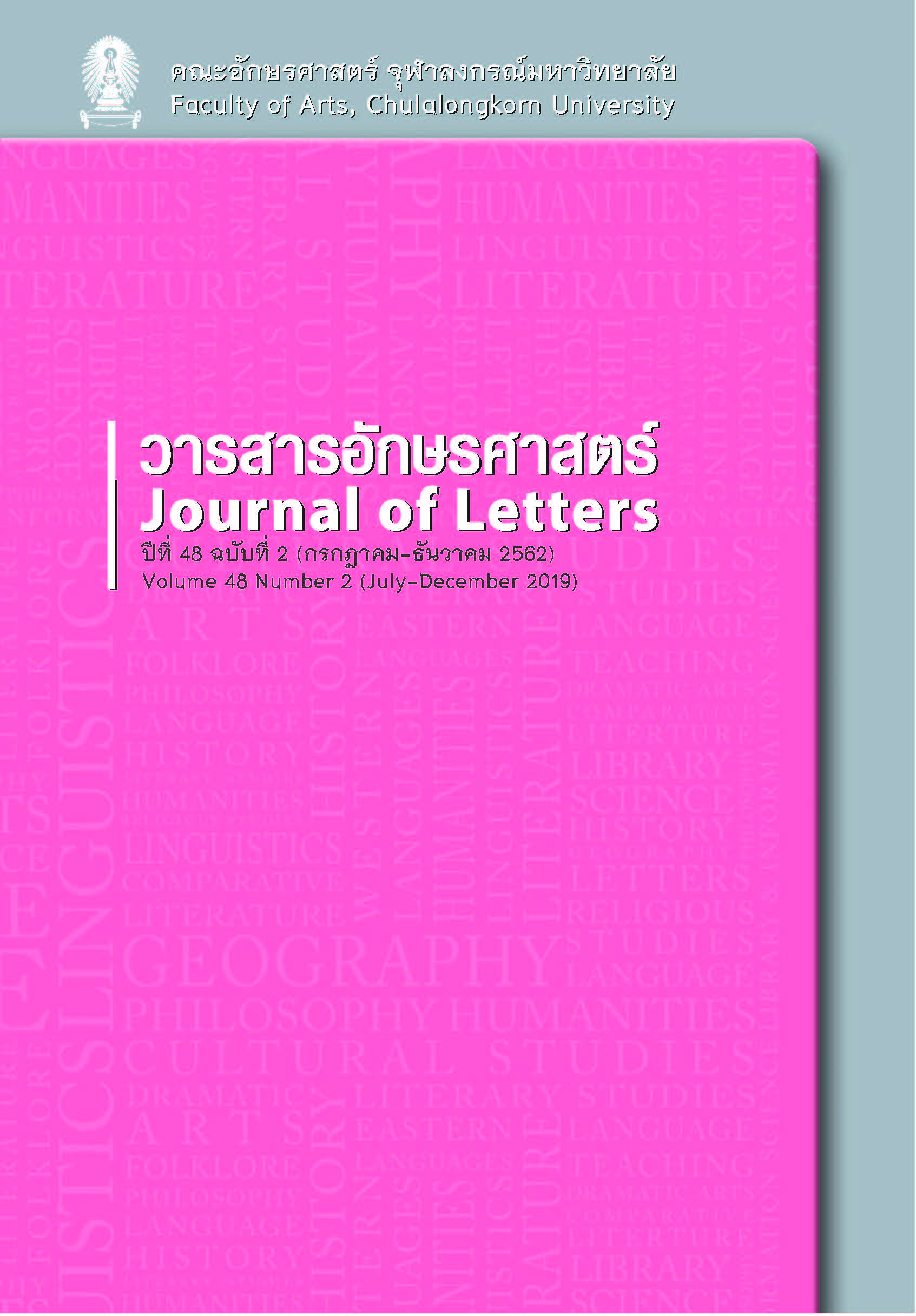Naming Characters in Thai Children’s Narratives
a Developmental Perspective
Keywords:
Child Language, Narratives, Frog Story, Character Reference, Thai ChildrenAbstract
The present study aims at investigating the referential forms used in naming narrative characters by Thai children and examining the developmental path of Thai children in character naming. Data from 40 narratives by 4, 6, 9 and 11-year-old children collected by Zlatev and Yangklang (2018) were used. Classified by the number of free morphemes, findings show that two types of referential forms are used: single and combined units. Single-unit forms can be nouns and pronouns, while combined units include two and three-unit combinations with various internal structures. It was found that older groups of children produced more combined-unit referential forms than single-unit ones. This implies the order of acquisition for single units is (COMMON NOUNS > PRONOUNS > PROPER NOUNS) and combined units (N+MOD > N+Det > N+POSS+N/Pron > N+Rel CL.)
References
Almgren, M., Beloki, L. & Manterola, I. 2008. The Acquisition of Narrative Skills by Spanish L1 and L2 Speakers. In Selected Proceedings of the 10th Hispanic Linguistics Symposium, Joyce Bruhn de Garavito, & Elena Valenzuela, eds., 146-156. Somerville, MA: Cascadilla Proceedings Project.
Bamberg, Michael. 1994. Development of Linguistic Forms: German. In Relating Events in Narrative: A Crosslinguistic Developmental Study, Ruth A. Berman, & Dan Isaac Slobin, eds., 189-237. NJ: Lawrence Erlbaum Associates.
Bates, E., Dale, P. S. & Thal, D. 1995. Individual Differences and Their Implications for Theories of Language Development. In The Handbook of Child Language, Paul Fletcher & Brian MacWhinney, eds., 96-151. Oxford: Blackwell.
Benedict, Helen. 1979. Early Lexical Development: Comprehension and Production. Journal of Child Language, 6(2): 183-200.
Berman, R. A., & Neeman, Y. 1994. Development of Linguistic Forms: Hebrew. In Relating Events in Narrative: A Crosslinguistic Developmental Study, Ruth A. Berman & Dan Isaac Slobin, eds., 285-328. NJ: Lawrence Erlbaum Associates.
Berman, R. A., & Slobin, D. I. 1994. Relating Events in Narrative: A Crosslinguistic Developmental Study. NJ: Lawrence Erlbaum Associates.
Disbray, Samantha. 2016. The Development of Reference Realization and Narrative in an Australian Contact Language, Wumpurrarni English. Frontiers in Psychology, 7(43). doi:10.3389/fpsyg.2016.00043
Goldfield, B. A., & Reznick, J. S. 1990. Early Lexical Acquisition: Rate, Content, and the Vocabulary Spurt. Journal of Child Language, 17(1): 171-183.
Ingram, David. 1989. First Language Acquisition: Method, Description, and Explanation. Cambridge: Cambridge University Press.
Jisa, H., & Kern, S. 1998. Relative Clauses in French Children’s Narrative Texts. Journal of Child Language, 25(3): 623-652.
Matthews, Danielle. 2014. Referential Communication. In Encyclopedia of Language Development, Patricia J. Brooks, & Vera Kempe, eds., 523-524. Thousand Oaks, CA: SAGE Publications.
Mayer, Mercer. 1969. Frog, Where are You? New York: Dial Press.
Ratitamkul, Theeraporn. 2010. Referential Choices in Narratives of 4-Year-Old Thai-Speaking Children. MANUSYA: Journal of Humanities Regular 13(1): 44-59.
Rungrojsuwan, Sorabud. 2003. “First Words: Communicative Development of 9- to 24-Month-Old Thai Children.” Doctoral dissertation, Chulalongkorn University, Bangkok.
Smith, Madorah E. 1926. “An Investigation of the Development of the Sentence and the Extent of Vocabulary in Young Children.” Doctoral dissertation, University of Iowa.
Zlatev, J., & Yangklang, P. 2001. Thai Frog Story Corpus. https://childes.talkbank.org/browser/index.php?url=Frogs/Thai-Zlatev/, accessed February 20, 2018.
Downloads
Published
How to Cite
Issue
Section
License
Copyright and plagiarism
Authors are responsible for obtaining permission to use copyrighted materials from copyright owners. Authors are responsible for observing requisite copyright law when quoting or reproducing copyrighted materials. Quotations and reproductions of content from other published sources must be accompanied by a reference and all sources should be clearly listed in the references section. Quotations and reproductions of content from external sources without due attribution could be considered a severe infringement of academic conduct and may constitute a legal offence under the Copyright Act of B.E. 2537. Any legal ramifications arising from the infringement of copyright regulations would be the sole responsibility of the author(s).



